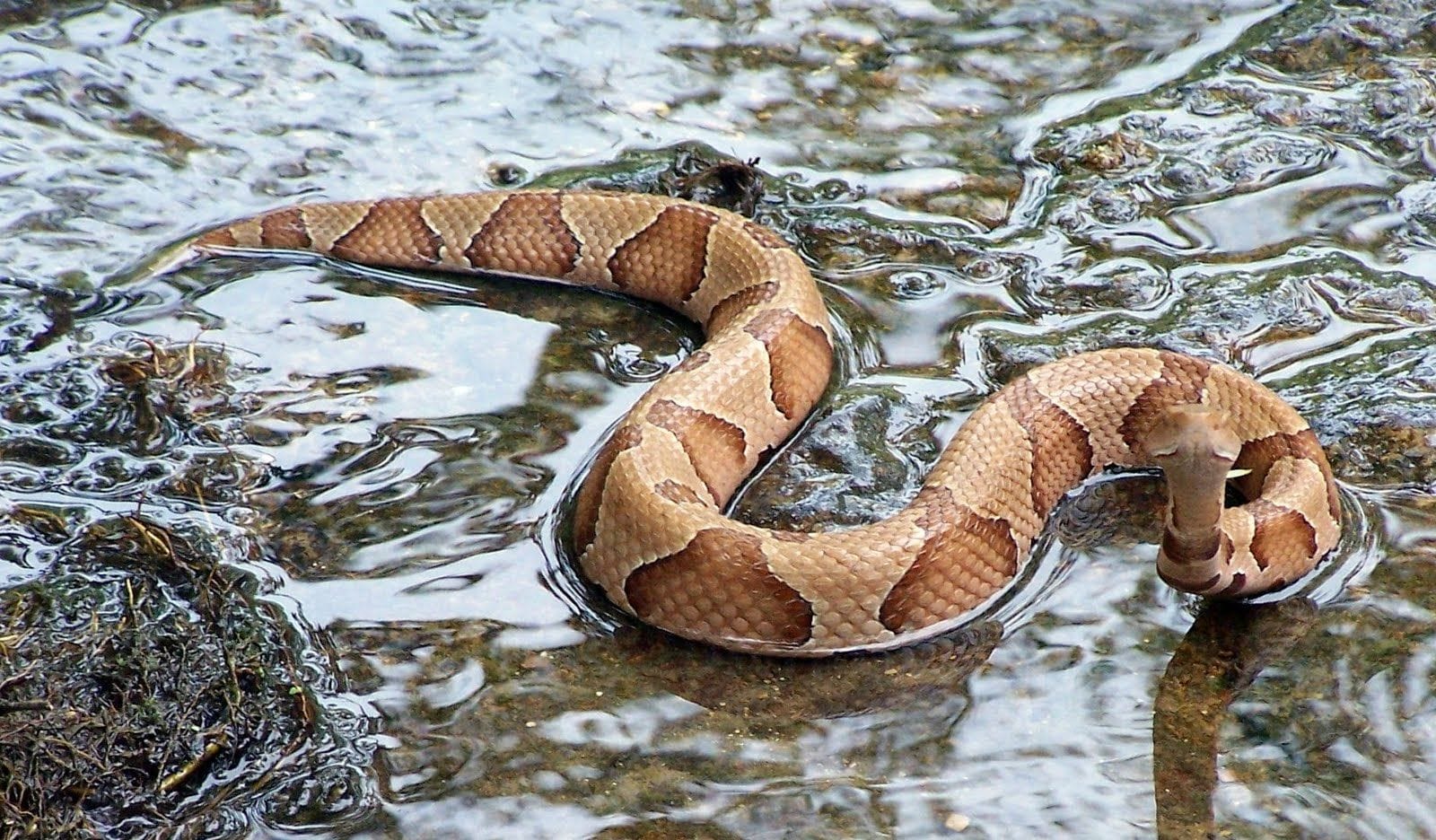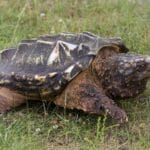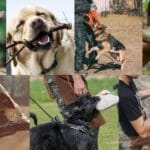Copperhead snakes: those captivating reddish-brown reptiles with a pattern that practically screams “look at me!” While their beauty is undeniable, their venomous bite reminds us to admire them from a safe distance. This comprehensive guide, complete with stunning images, will equip you to confidently identify copperheads, understand their behavior, and coexist safely in their domain.
Decoding the Copperhead: Key Identification Features
Mistaking a harmless snake for a venomous copperhead can lead to unnecessary fear and potential harm to both humans and snakes. Therefore, accurate identification is crucial. Here’s what to look for:
The Hourglass Markings: A Signature Pattern
The most distinctive feature of a copperhead is its hourglass-shaped markings. These striking patterns, rich reddish-brown against a lighter background, run down the length of their back and are a dead giveaway. Imagine a row of chocolate kisses pressed onto caramel – that’s the general idea! However, keep in mind that these markings can be faint or less defined in some individuals.
Head Shape and Features
Copperheads sport a triangular-shaped head, broad and distinct from their neck, reminiscent of a pit viper’s classic look. They also possess heat-sensing pits, those two small depressions located between their eyes and nostrils. These fascinating sensory organs help them locate warm-blooded prey even in low-light conditions.
Body Type and Color Variations
Built more for ambush than speed, copperheads have a stocky, muscular build. While their name suggests a coppery hue, these snakes can range in color from light tan to a rich, coppery brown, sometimes even bordering on a pinkish shade. Juvenile copperheads often have a bright yellow or greenish-yellow tip on their tails, which they may use to lure prey.
Beyond the Bite: Biology and Behavior of the Copperhead
Understanding a copperhead’s biology and behavior is key to appreciating their role in the ecosystem and dispelling common misconceptions. Let’s debunk some myths and uncover fascinating facts about these often-misunderstood reptiles.
Venom: A Defensive Tool, Not a Weapon
Copperheads are venomous, but their venom is primarily used to subdue prey, usually small rodents, amphibians, and insects. While a copperhead bite can be painful and requires immediate medical attention, fatal bites are extremely rare, especially with prompt treatment. In fact, copperheads often deliver “dry bites,” where no venom is injected at all. This is likely a conservation strategy, as producing venom is energetically costly for the snake.
Habitat and Range
Copperheads are adaptable and can thrive in a variety of environments across the eastern and central United States. You might encounter them in forests, woodlands, swamps, rocky areas, and even suburban gardens. They are particularly fond of edge habitats, those transitional zones between different environments, like the border between a forest and a field.
Ambush Predators: Masters of Disguise
Copperheads are ambush predators, preferring to lie in wait for their prey rather than actively hunting it down. Their cryptic coloration allows them to blend seamlessly into leaf litter, making them nearly invisible to unsuspecting prey. This sit-and-wait strategy conserves energy and makes them highly effective hunters.
A Shy Serpent: More Likely to Retreat Than Attack
Despite their venomous reputation, copperheads are generally shy and non-confrontational. Given the chance, they are much more likely to retreat and avoid contact with humans. However, if they feel threatened or cornered, they will defend themselves. Understanding their behavior and respecting their space is paramount to peaceful coexistence.
Copperhead Encounters: Safety and Coexistence Strategies
Living in copperhead country requires understanding how to coexist safely with these venomous reptiles. Here are some essential tips:
Be Aware of Your Surroundings
When exploring potential copperhead habitats, stay vigilant and watch where you step, especially in areas with leaf litter, dense vegetation, rocky outcrops, or near water sources.
Give Them Space
If you spot a copperhead, observe it from a safe distance, but never try to handle, harass, or kill it. Remember, they would much rather avoid you than engage in a confrontation.
Don’t Disturb Their Homes
Avoid putting your hands or feet in places where you can’t see clearly, like woodpiles, rock crevices, or under logs, as these are potential hiding spots for copperheads and other snakes.
Keep Pets Leashed
Curious pets can be at risk, so always keep them on a leash when in areas where copperheads may be present. If you suspect your pet has been bitten by a copperhead, seek immediate veterinary care.
First Aid for Copperhead Bites
While fatal copperhead bites are rare, any bite from a venomous snake requires immediate medical attention. Here’s what to do:
- Safety First: Move away from the snake calmly and quickly, putting distance between you and the snake.
- Call for Help: Immediately call 911 or your local Poison Control Center.
- Stay Calm: Try to remain calm and still to slow the spread of venom.
- Remove Constrictive Items: Take off any jewelry or tight clothing from the affected area, as swelling may occur.
- Immobilize the Limb: If possible, keep the bitten limb still and lower than your heart.
- What Not to Do:
- Do not apply ice or a tourniquet to the bite.
- Do not try to suck out the venom.
- Do not attempt to capture or kill the snake.
Protecting Copperheads: Conservation Matters
Like many reptiles, copperhead populations are threatened by habitat loss, human persecution, and other environmental factors. By appreciating their role in the ecosystem, promoting understanding, and advocating for their conservation, we can help ensure that copperheads continue to thrive.
Copperhead Look-Alikes: Distinguishing Similar Species
Copperheads are often confused with several harmless snake species, leading to unnecessary fear and potential harm to non-venomous reptiles. To avoid misidentification, it’s essential to be able to distinguish copperheads from their look-alikes. Here’s a comparison guide:
Copperhead vs. Northern Water Snake
- Pattern: Copperheads have hourglass-shaped markings; Northern Water Snakes have alternating dark brown bands that are wider at the edges, creating a chain-like effect.
- Body Shape: Copperheads are stout and thick-bodied; Northern Water Snakes are more slender and less bulky.
- Head Shape: Copperheads have a distinctly triangular head; Northern Water Snakes have a more rounded head shape.
- Behavior: Copperheads are more likely to freeze or vibrate their tails when threatened; Northern Water Snakes are known for their feisty disposition and may flatten their heads and strike defensively.
Copperhead vs. Eastern Milk Snake
- Pattern: Copperheads have hourglass-shaped markings that are wider at the sides and narrow in the middle; Eastern Milk Snakes have reddish-brown blotches outlined in black that resemble the markings of a king snake but are proportionally larger.
- Head Shape: Copperheads have a triangular head; Eastern Milk Snakes have a more rounded head shape.
- Defense Mechanism: Copperheads are venomous; Eastern Milk Snakes are non-venomous and may shake their tails in leaf litter to mimic a rattlesnake when threatened.
Copperhead vs. Rat Snake
- Pattern: Copperheads have hourglass-shaped markings; Rat Snakes are typically uniformly black or gray with a white or yellow belly.
- Head Shape: Copperheads have a triangular head with heat-sensing pits; Rat Snakes have a smaller, less pointy head.
- Pupil Shape: Copperheads have vertical pupils; Rat Snakes have round pupils.
- Defense Mechanism: Copperheads are venomous; Rat Snakes are non-venomous constrictors.
Copperhead vs. Brown Snake
- Pattern: Copperheads have hourglass-shaped markings; Brown Snakes have more irregular blotches or stripes.
- Head Shape: Copperheads have a triangular head; Brown Snakes have a rounded or oval-shaped head.
- Pupil Shape: Copperheads have vertical pupils; Brown Snakes have round pupils.
- Size: Copperheads are generally larger than Brown Snakes.
If you are a huge fan of these scary yet fascinating creatures, then we recommend you to visit our page pictures of snapping turtles, where you can find more about them.
Recently, a new image of the great pyramid of Khufu has been released. To see this highly anticipated image, visit our page pictures of the great pyramid of khufu.
Remember: This guide is for informational purposes only and does not substitute for professional advice. If you encounter a snake and are unsure of its identification, err on the side of caution, observe it from a safe distance, and contact your local wildlife agency or animal control if necessary.
- Unveiling the Enigma: Mansoureh Khojasteh Bagherzadeh’s Public Appearances & Private Life in Iran - July 18, 2025
- Unveiling the Mystery: Mansoureh Khojasteh Bagherzadeh’s Husband: A Rare Glimpse into a Private Life - July 18, 2025
- Unveiling Masoud Khamenei’s Mother: Power, Influence, and Iran’s Future - July 18, 2025
















